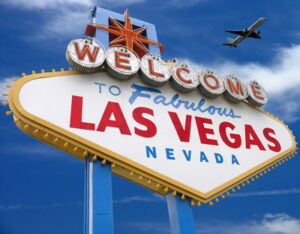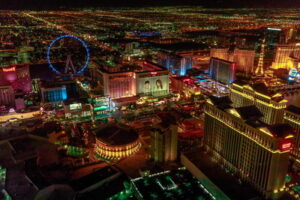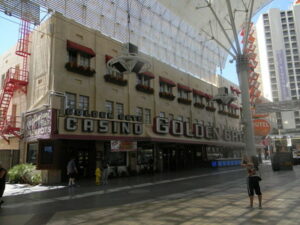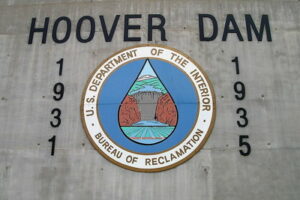 Las Vegas is the world’s haven for gambling. The Las Vegas Strip plays host to a vast number of casinos. People from around the world visit every year to have one of the best experiences of their lives. The glitz, glamour and flashing lights of the city draw players in.
Las Vegas is the world’s haven for gambling. The Las Vegas Strip plays host to a vast number of casinos. People from around the world visit every year to have one of the best experiences of their lives. The glitz, glamour and flashing lights of the city draw players in.
Of course, Vegas hasn’t always been the city of lights that it is today. Way back in the day, it started out its life as a small town for travellers to pass through. Few could have known that it would reach the heights it has in modern times. Yet it does beg the question of where Vegas actually got its name from.
Cities around the world receive their names in honour of someone or something. New York City used to go by the name of New Amsterdam, for example. That came about when it was under Dutch rule. Yet once the English captured it, it became New York in honour of the Duke of York. He had organised the English navy’s mission to New Amsterdam.
If you look at London, this city’s name comes from a word in Latin, Londinium. It became the capital of Roman Britain in history. Before this, it had a reference in Historia Regum Britanniae. Within, it describes Londinium as coming from King Lud, who seized the city Trinovantum. He wanted it renamed to Kaerlud. That developed into Karelundein and then into London.
What is the idea behind the name Las Vegas? Here, we’re going to see if we can dissect what it all represents and why it has this name.
The History of Las Vegas Before It Became ‘The City of Lights’
 If you go back many, many centuries, the prehistoric landscape of Las Vegas valley was once a marsh. Water and vegetation thrived there, as was the case for much of Southern Nevada. The rivers that created this marsh, after many years, went underground.
If you go back many, many centuries, the prehistoric landscape of Las Vegas valley was once a marsh. Water and vegetation thrived there, as was the case for much of Southern Nevada. The rivers that created this marsh, after many years, went underground.
The marsh then receded, which made the valley evolve into a dry landscape. It could only support the toughest animals and plants as a result. Yet at some point, the water resurfaced and flowed into the modern-day Colorado River. From this, a wealth of plant life helped to form a wetland oasis.
Over 10,000 years ago, Native Americans lived in the Las Vegas Valley for a long time. Excavators have found remnants from the times of the Mojave and Paiute tribes.
It was in the early 1700s that Spanish traders began making their way overseas to Los Angeles. This all took place via the Spanish Trail. It wasn’t until about a century later that things started to come together for Las Vegas. Antonio Mariano Armijo, a Spanish explorer and merchant, helped found Las Vegas. He led the first commercial caravan party between Abiquiú in New Mexico and San Gabriel Mission in California. That occurred between 1829 and 1830. The route he took – the southernmost and most direct – became known as the Armijo Route.
Abiquiú was the starting point of the Old Spanish Trail. Some Spanish colonies had taken certain segments of an overland route before. Yet Armijo was the first to complete a wholly overground route. He took 60 mounted men and a caravan of pack animals transporting goods. These were so that he could barter for mules in California. During the journey, they came upon the Las Vegas Valley. Armijo, documenting every part of his journey, described it as the best point to re-supply. The travellers would name the area Las Vegas. Translated from Spanish, it means “The Meadows” or “Fertile Plains”.
The 5th Governor of Arizona Territory, John C. Frémont, travelled to Vegas on May 3, 1844. At the time, it was still a part of Mexico. President John Tyler appointed Frémont as the leader of a group of scientists, scouts and spies. They were working for the US Army Corps of Engineers. At the time, a possible war with Mexico was brewing. Fremont and his troop made camp at the Las Vegas Springs upon their arrival in the valley. The war with Mexico did take place, resulting in that region becoming U.S. territory.
The fort set up by Frémont would remain standing and used by many. This included travellers, mountain men, hunters and traders. Yet it was never inhabited on a permanent basis. It remained as a place for travellers to take shelter for many years. In 1855, William Bringhurst led a group of Mormon missionaries from Utah to Vegas. They built a 150-square-foot adobe fort near a creek. They used floor irrigation for their crops. Yet various tensions and overwhelming summer heat led to them abandoning it.
They returned to Utah in 1857. It was only in 1864 that significant activity occurred once again. The U.S. Army attempted to deceive Confederate spies operating in Southern California. They made a false claim that they had reclaimed the fort, renaming it Fort Baker. After the end of the war in 1865, the fort was re-occupied by Octavius Gass. He began irrigating the old fields and renamed the area to Las Vegas Rancho.
Once Gass began making his own wine there, Vegas became known as the best stop on the Old Spanish Trail. He lost the ranch to Archibald Stewart in 1881. Three years later, his wife became the Las Vegas postmaster. The property then increased to 1,800 acres and stayed within the family until 1902. That marked the year that the San Pedro, Los Angeles and Salt Lake Railroad purchased it.
The Beginning of a New City

By the beginning of the 20th century, Vegas had water piped in via wells. This provided a reliable source of fresh water and the potential for extra growth. Because of this, it was an ideal water stop for wagon trains and railroads between LA and Albuquerque. The San Pedro, Los Angeles & Salt Lake Railroad completed in 1905. This linked Salt Lake City to Southern California. A second railroad branching off from Vegas to the town of Bullfrog was also constructed and due to revenue coming down both railways, Las Vegas grew at a swift pace.
In May of 1905, 110 acres of Las Vegas went to auction for ready buyers. At this point, it became a city. The 110 acres auctioned off would later become the city’s downtown area. Vegas would become the driving force behind the creation of Clark County in Nevada in 1909. It was within this county that Vegas became incorporated as an official city in 1911. The first mayor of the city was Peter Buol, who served from 1911 to 1913.
The city went through some development a few years before this. The installation of the first flowing groundwater well came about in 1907. By 1912, groundwater discharge from the wells was around 15,000 acre-feet per year.
When the auction took place in 1905, John F. Miller was one of the first visiting Vegas. He bought a $1,750 parcel at the southeast corner of Main Street and Fremont Street. It wasn’t long before he set up the Miller Hotel on the property. He went on to expand this, making it a two-storey hotel structure by the following year. From the start, the hotel’s ground-floor played host to a casino room. There, visitors could experience games of poker and blackjack during their stay. That casino kept running until 1909. Gambling across the U.S. was being outlawed state-by-state. Miller placed all his gambling tables into storage as a result. Nevada succumbed to the gambling ban shortly after its incorporation as a city.
The laws on gambling were very strict. They even banned the flipping of a coin for the price of a drink, which had become a western custom. Despite this, the city thrived, thanks to a diversified economy and stable businesses. Las Vegas continued its growth until 1917. Yet the railroad connecting to Bullfrog (Las Vegas and Tonopah Railroad) declared bankruptcy that year. The Union Pacific Railroad purchased the remains of the company. Yet a nationwide strike in 1922 left Vegas in quite a dire state.
The Hoover Dam Brings Gambling Back to Las Vegas

Even though outlawed, gambling continued in illicit casinos and speakeasies. The ban on the activity ceased in 1931, thanks to the construction of the Hoover Dam. The population of nearby Las Vegas swelled, with construction workers moving to help build it. The population of 5,000 boomed to an overwhelming 25,000. Most of the newcomers sought out jobs building the dam. Of course, the Great Depression fuelled their desire for work.
Because so many men came from across the U.S., it also created another market. Large-scale entertainment was necessary to keep everyone happ and a combination of local Vegas business owners and Mafia crime lords began their work. Casinos and showgirl theatres opened their doors to provide entertainment to the dam workers.
It wasn’t to last for the dam workers, though. A visit to the site by Ray Lyman Wilbur in 1929 occurred. As the Secretary of the Interior, Wilbur arrived to inspect the dam’s construction. Unfortunately, a worker had alcohol on his breath after a visit to Block 16 in Vegas. At the time, Prohibition was in full effect across the USA. The government chose to erect a controlled town, Boulder City, and all the dam workers were rehomed there.
Yet this didn’t stop Las Vegas from progressing on the gambling path. The Nevada state legislature legalised the activity on a local level in 1931. Realising how profitable gambling would be for local businesses, it kick-started the city. It was this that started the Las Vegas rise towards the gaming capital of the world. The legislature provided the first gambling licence in 1931 to the Northern Club. Soon after this, many other casinos obtained such a licence on Fremont Street. It was this street that also became the first paved street in Vegas. Furthermore, it received the first traffic light in 1931, too.
Dam workers were not allowed to visit Las Vegas, by order of the federal government. As a result, smuggling and circuitous routes were set up. The city’s leading figures responded to this by purging gambling dens of workers. This did, of course, see declines at gambling venues. Yet the business downturn didn’t last long, as the Hoover Dam opened in 1935. Southern Nevada Power became the first utility to supply power from the dam. Las Vegas would then become its first customer. With electricity flowing into Vegas, Fremont Street became known as Glitter Gulch. Why? Because many bright lights shone throughout, thanks to the Hoover Dam’s electricity supply.
Would Las Vegas end up as ‘The City of Lights’ without the building of the dam? There is the potential for it not to be the case, indeed. The completion of the dam meant that worker population disappeared. Yet the dam itself and its reservoir Lake Mead became tourist attractions. From this, there was a demand for higher-class hotels. Many of these incorporated casinos into their establishments, too.
The changes in Las Vegas were swift and effective from that point on. Gone were the days of a small railroad stopover fort. In a few decades, it had transformed into a bustling city. Top-quality hotels, entertaining casinos, and more were on offer to visitors.
The beginning of modern Las Vegas as we know it today started in 1966. It was at this point that Howard Hughes, a hero of the aviation industry, moved to Vegas. In his initial days, he stayed at the Desert Inn hotel, and then refused to vacate his room afterwards. He instead chose to buy the entire hotel. He would then go on to extend his empire. This saw him buy real estate, hotels, media outlets and more. From his estimated $300 million expenditure, he began changing Vegas from its Wild West roots. It was well on the road towards becoming a cosmopolitan city instead.
Las Vegas may not look like an oasis for hungry and thirsty travellers anymore. Yet that is where its name comes from – the fertile nature of the ground. It has since gone through vast changes and become a monolithic city within Nevada. It now serves as an oasis for avid gamblers!
